#dave brubeck house
Text


Late jazz legend Dave Brubeck's 1953 MCM cantilevered house in Oakland, California is on the market for $3M. It has 4bds, 4ba, and is cantilevered 16 ft. in the air. Designed by architect Beverley D. Thorne.


Five steel beams project in two directions allowing the house to "float" above the challenging hillside lot, while preserving the natural beauty of a site that commands a magnificent panoramic view of the San Francisco Bay.
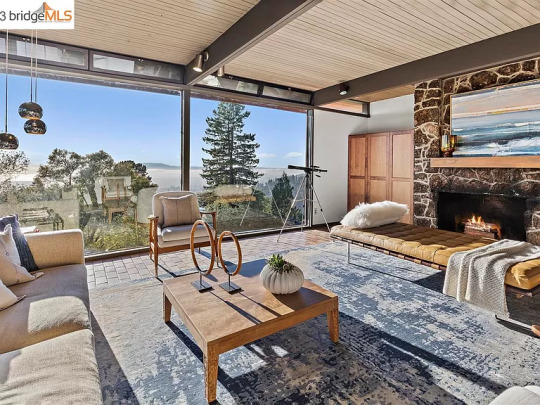

The spacious living room features glass walls for a great view, plus a stone fireplace.
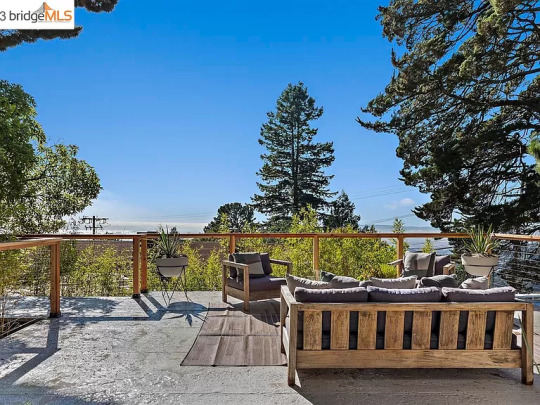
This deck has the best view of San Francisco Bay.


It's a dinette now, but it used to be the music room where the Dave Brubeck Quartet practiced. It's famous for the rock projecting out of the center of the house.

I think the rock is the coolest feature. It sort of looks like a frog.


The large kitchen has been updated, but the cabinetry looks like original MCM style.

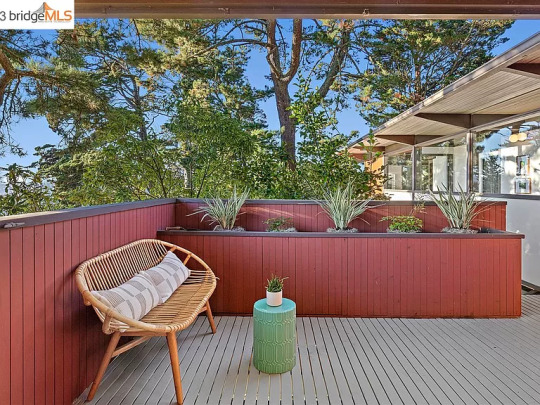
A small area of the kitchen has a bistro table set and opens to this deck.
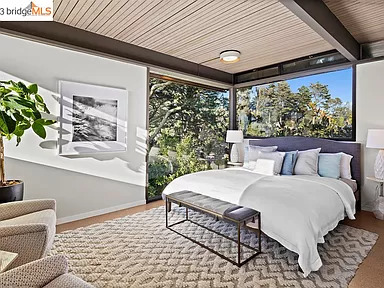

Large primary bedroom is divided into 2 areas.

Bedroom #2 has a nook with a desk.

Bedroom #3 is smaller and painted a pleasant blue.

Small exercise space has a nice view.

This patio looks like it's almost as high as the roof.
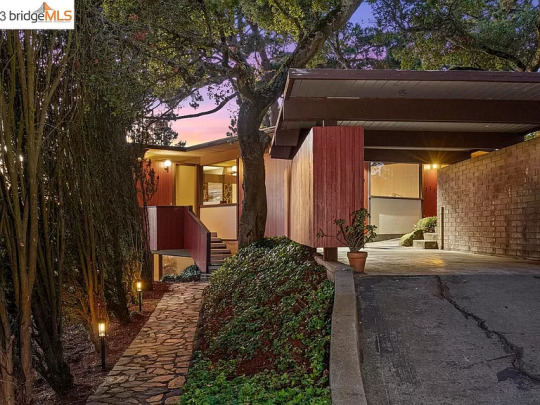
The drive leading up to the front door has a carport.

You can see here how the house is built among the rocks.

Check out the view at night.
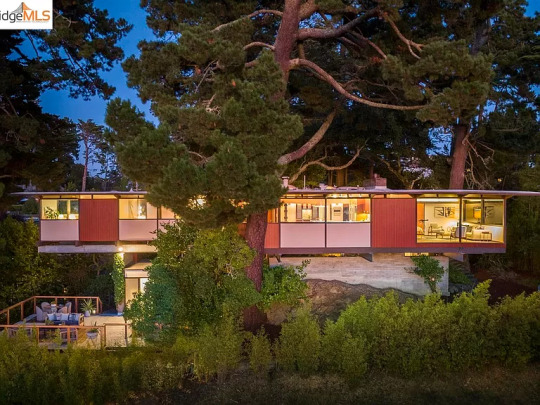
Attractive home balanced above a rocky .29 acre lot.

Aerial view showing the location.
#unique mid century modern home#mid century modern home#cantilevered house#dave brubeck house#old house dreams#houses#house tours#home tour
263 notes
·
View notes
Photo
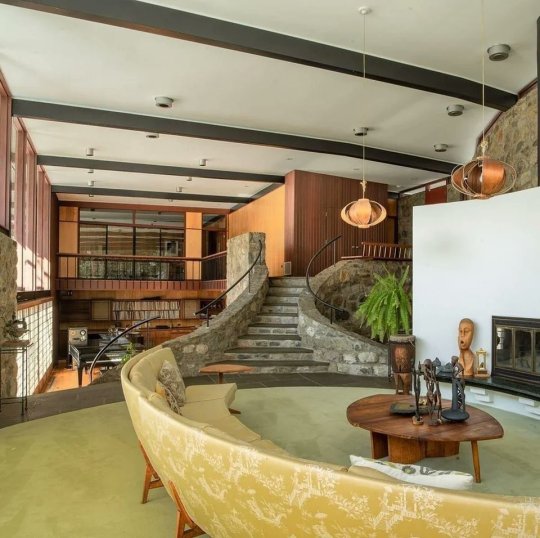
228 notes
·
View notes
Text

Beverly Thorne built this house for jazz legend, Dave Brubeck, and his wife Iola.
#beverly thorne#architecture#modernist architecture#architectural design#modernism#house design#dave brubeck#jazz
4 notes
·
View notes
Text


























Située à Oakland, en Californie, la Brubeck House, l'ancienne maison du musicien Dave Brubeck, conçue par l'architecte Beverley D. Thorne en 1953. Photo via Zillow. - source MCM Daily.
57 notes
·
View notes
Text
Dale Cooper: A Twin Peaks playlist.
Featuring: Angelo Badalamenti, Julee Cruise, The Cure, Cocteau Twins, Harold Budd, The Dave Brubeck Quartet, The Magnetic Fields, Brian Eno, Tears for Fears, The Legendary Pink Dots, Beach House, Scott Walker, The Ventures, Dead Can Dance, John Cale, The Cleaners From Venus, The Jesus and Mary Chain, The Durutti Column, Bill Evans Trio, Chet Baker, This Mortal Coil, Them Are Us Too, Jon Hassell, Roy Orbison, Psychic TV, Tuxedomoon, Cult With No Name, Talk Talk, Chromatics, Kate Bush, David Sylvian, The Field Mice, Eddie Vedder, Spiritualized, The Chameleons and Peter Gabriel.
Genres featured: Ambient, dream pop, gothic rock, alternative rock, electro pop, new-wave, jazz and post rock.
13 notes
·
View notes
Text




youtube
Music I like from my vinyl record collection -
David Warren Brubeck (December 6, 1920, Concord, California – December 5, 2012, Norwalk, Connecticut), known as Dave Brubeck, was an American jazz pianist. He wrote a number of jazz standards, such as In Your Own Sweet Way or The Duke. Brubeck's style ranges from sleek, classy compositions to grandiose masterpieces.
While creating, he took advantage of his mother's teaching and his brilliant ability to improvise. He experimented with unusual time signatures in a number of his compositions. Together with Paul Desmond, Joe Morello and Eugene Wright, they formed The Dave Brubeck Quartet, popular in their time.
His long-time collaborator, alto saxophonist Paul Desmond, wrote the Brubeck Quartet's best-known piece, Take Five, which is in 5/4 time. Experiments with the timing of songs accompanied a significant part of Brubeck's musical career, such as Pick Up Sticks, Unsquare Dance, and Blue Rondo à la Turk.]
Brubeck's mother studied piano in England, planned a career as a concert pianist, and made extra money by teaching piano. But Brubeck did not particularly enjoy the constant playback of scores, rather he tried to compose his own melodies. He started studying piano at university, but after one of the professors discovered that he couldn't even play the notes properly, he wanted to expel him. Fortunately, other professors stood up for him. They claimed that his ability to manage counterpoint and harmony was above average. But the school was still worried that Brubeck might cause a scandal and let him graduate only on the condition that he never teach piano.
In 1942, he successfully completed his studies at the university and immediately afterwards enlisted in the army. It was the war years, so he served in the army for 4 years (he even took part in the Battle of the Bulge). After returning, he continued his studies, this time in California. After completing his studies, he signed with the California record company Fantasy Records. He founded his own octet, but also played in a trio at the same time. Later, alto saxophonist Paul Desmond joined the trio. They started experimenting, recorded a few records, but still had few opportunities to play. Brubeck was quite disgusted by this, so he returned to the trio again. Again without Desmond, who secured appearances with a different line-up. So Brubeck spent several years just playing jazz standards over and over.
The Dave Brubeck Quartet
After a short hiatus caused by Brubeck's back injury while swimming, The Dave Brubeck Quartet is formed in 1951. Paul Desmond played the saxophone in it again. The quartet got a long-term engagement in a club in San Francisco, but it became more widely known through its regular concerts in student dormitories. Three albums emerged from these concerts: Jazz at Oberlin, Jazz Goes to College, and Jazz Goes to Junior College. In 1954, Brubeck's photo appeared on the cover of the prestigious American magazine Time - he was only the second jazz musician to be on the cover of this magazine (the first was Louis Armstrong).
The Dave Brubeck Quartet in 1967. Left to right: Joe Morello, Eugene Wright, Brubeck and Paul Desmond.
In the mid-1950s, original quartet members Bob Bates and Joe Dodge were replaced by Eugene Wright and Joe Morello. Because Wright was African-American, Brubeck had to cancel a lot of concerts in the late 1950s. Club owners were willing to organize a concert, but they set the condition that the quartet must have a white double bassist. Brubeck also canceled a television appearance after learning that the camera was intentionally not focusing on Wright.
In 1959, the quartet releases the album Time Out. Although the music publishing house was enthusiastic about it, it delayed its release a little. The album is special in that almost none of the songs on it are in regular time signature. The album includes the compositions Take Five, Blue Rondo à la Turk or Pick Up Sticks, which are already considered jazz standards today. Despite experimenting with unusual time signatures, the album sold very well and soon went platinum.
During this time, Brubeck and his wife wrote the musical The Real Ambassadors, which depicts their experiences touring the United States. The soundtrack to this musical was recorded in 1961. It featured Louis Armstrong, Lambert, Hendricks & Ross and Carmen McRae. The musical itself premiered a year later.
The quartet followed up the success of Time Out with similar albums: Time Further Out: Mirror Reflections, Countdown: Time in Outer Space, Time Changes and Time In. All these albums are also known for the fact that the covers were created by modern painters of the time - Joan Miró, Sam Francis or Franz Kline. This was also the time for the live album At Carnegie Hall, which critic Richard Palmer called "undoubtedly Brubeck's best concert".

10 notes
·
View notes
Text
LÉGENDES DU JAZZ
CURTIS COUNCE, LA TROP BRÈVE HISTOIRE D’UN GROUPE D’EXCEPTION
‘’While it lasted, the Curtis Counce Group was one of the most exciting ever organized in Los Angeles. Counce picked four men who almost immediately achieved a togetherness only long-established bands seem to have. Today, Carl Perkins is dead, and the members of the group have gone off in different directions... It would be difficult under the best conditions to recapture the feeling of the 1957 quintet. Without Perkins whose unique piano style was basic to the group’s special sound, it is impossible.’’
- Les Koenig
Né le 23 janvier 1926 à Kansas City, au Missouri, Curtis Counce s’est installé en Californie en 1945. En Californie, Counce s’était fait la main en se produisant au célèbre club Alabam aux côtés de grands noms du jazz comme Johnny Otis et Art Farmer. Il avait aussi joué avec Wardell Gray, Hampton Hawes, Benny Carter, Shorty Rogers et Buddy DeFranco.
Counce avait commencé à enregistrer en 1946 avec Lester Young. Dans les années 1950, Counce avait enregistré avec d’autres grands noms du jazz comme Shorty Rogers, Stan Kenton, Shelly Manne, Lyle Murphy, Teddy Charles et Clifford Brown.
Après avoir fait une tournée en Europe avec l’orchestre de Stan Kenton en 1956, Counce avait formé son propre quintet en août de la même année. Le groupe comprenait le saxophoniste Harold Land (un ancien membre du célèbre quartet de Max Roach), le trompettiste Jack Sheldon (parfois remplacé par Gerald Wilson), le pianiste Carl Perkins et le batteur Frank Butler. Le groupe avait fait ses débuts dans un célèbre club bebop de Los Angeles, The Haig. Le groupe se produisait aussi dans un club appelé la Sanborn House. Land expliquait: ‘’There was another pot down on Sunset: the Sanborn House. We played there quite a while, longer than we did at The Haig, and the group built up quite a following. The Haig was very small, but this was a large club.’’
Seul élément blanc du groupe, Sheldon était né à Jacksonville, en Floride, le 30 novembre 1931. Après s’être installé à Los Angeles en 1947, Sheldon avait étudié la musique durant deux ans au L.A. City College. Après un séjour de deux ans dans l’armée de l’air, Sheldon avait joué avec Jack Monrose, Art Pepper, Wardell Gray, Dexter Gordon et Herb Geller. Il avait aussi fait partie des membres fondateurs du groupe de Joe Maini et Lenny Bruce.
En plus de Counce, la section rythmique du groupe était composée de deux musiciens d’exception, le pianiste Carl Perkins (sans lien de parenté avec le chanteur rock du même nom) et le batteur Frank Butler. Né à Indianapolis, en Indiana, Perkins avait fait partie des groupes de rhythm & blues de Tiny Bradshaw et Big Jay McNeely avec qui il avait développé un solide sens du blues. Doté d’un style peu conventionnel, Perkins jouait souvent avec le bras gauche parallèle au clavier. Né le 18 février 1928 à Wichita, au Kansas, le batteur Frank Butler avait joué avec Dave Brubeck, Edgar Hayes et Duke Ellington, entre autres.
Aucun des membres du groupe n’était un musicien vedette, même si Land avait acquis une certaine célébrité durant son séjour avec le groupe de Max Roach et de Clifford Brown. Même si l’initiative de la fondation du groupe revenait à Counce, il s’agissait surtout d’un groupe coopératif où chacun des membres était un partenaire à part entière. On pourrait même dire que la formation était une sorte d’anti-groupe, en ce sens qu’il était beaucoup plus que la somme de ses parties. Harold Land expliquait: ‘’We were all close friends within the group, so it was a good idea for all of us, because we all liked each other personally as well as musically.’’
Fondateur des disques Contemporary, Lester Koenig avait toujours eu le don de dénicher des nouveaux talents. Dans la seconde moitié des années 1950, Koenig avait donné sa chance à une vaste gamme de musiciens prometteurs, dont Ornette Coleman et Cecil Taylor. Le 8 octobre, seulement un mois après que le groupe de Counce ait fait ses débuts au club The Haig, Koenig l’avait invité à entrer en studio. La chimie du groupe avait été évidente dès le départ.
La première pièce que le groupe avait enregistrée était ‘’Langslide’’, un thème de hard bop de Land. Perkins et Sheldon avaient également collaboré au répertoire du groupe avec deux compositions: ‘’Mia’’ et ‘’Sarah.’’ La session comprenait aussi une reprise de la composition ‘’Big Foot’’ de Charlie Parker que le saxophoniste avait enregistrée sous le titre d’’’Air Conditioning’’ et de ‘’Drifting on a Reed’’ pour les disques Dial. Le groupe était revenu en studio le 18 octobre pour enregistrer une dernière pièce: ‘’Sonar’’ de Gerald Wiggins et Kenny Clarke.
Publié sous le titre de The Curtis Counce Group, le premier album de la formation était paru au début de 1957 et avait remporté un succès immédiat. Le critique Nat Hentoff du magazine Down Beat était si enthousiaste qu’il avait accordé quatre étoiles à l’album. Mais le groupe ne faisant pas de tournées et se produisant surtout dans la région de Los Angeles, il était demeuré très peu connu sur la scène nationale. Même si Land se rappelait que le groupe s’était déjà rendu jusqu’à Denver, au Colorado, il ne s’était rien produit à son retour dans l’est. Bien que la formation soit très populaire à Los Angeles, elle n’avait pu rivaliser avec son principal concurrent, le quintet de Chico Hamilton.
À la fin de 1957, le groupe avait publié un deuxième album qui est aujourd’hui considéré comme un classique, You Get More Bounce With Curtis Counce. D’abord publié avec une blonde pulpeuse portant un décolleté plongeant sur la pochette, l’album avait été réédité plus tard avec une illustration beaucoup moins provocante. L’album avait été enregistré dans le cadre de différentes sessions tenues en 1956 et 1957. En plus de la pièce ‘’Sonar’’ qui faisait partie des sessions de l’album précédent, le groupe avait enregistré une version swing de ‘’Stranger in Paradise’’ lors de la seconde session du 15 octobre 1946. Outre la pièce ‘’Big Foot’’ mentionnée plus haut, l’album comprenait également deux pièces qui avaient été enregistrées le 22 avril 1957: ‘’Too Close for Comfort’’ et ‘’Counceltation.’’ Cette dernière pièce était une composition de Counce. À l’époque, Counce étudiait la composition avec Lyle ‘’Spud’’ Murphy. ‘’Counceltation’’ était une pièce expérimentale basée sur le système à douze tonalités de Murphy. La pièce était intéressante, même si elle était un peu trop cérébrale et académique pour être appréciée par un large public. L’album comprenait également une autre composition de Counce intitulée ‘’Complete’’ qui avait été enregistrée en mai. Une version du standard ‘’How Deep is the Ocean’’ faisait partie de la même session. Quant au classique ‘’Mean to Me’’ souvent associé à Billie Holiday, il avait été enregistré en septembre.
Lorsque l’album avait été publié à la fin de 1957, le groupe semblait promis à un brillant avenir. Malheureusement, une série d’événements malheureux avaient contribué au déclin du groupe: la mort du pianiste Carl Perkins à l’âge de vingt-neuf ans en 1958 d’abord (il avait été remplacé par Elmo Hope), puis la baisse de popularité du jazz dans les clubs de Los Angeles à la fin de la même décennie.
Expliquant le déclin du jazz à Los Angeles à la fin des années 1950, l’historien Ted Gioia écrivait dans son ouvrage West Coast Jazz: Modern Jazz in California, 1945-1960, publié en 1998:
‘’The great flowering of modern jazz on the West Coast, which had begun in the mid-1940s on the street of Central Avenue, had reached a dead-end, financially if not creatively. It’s place in Southern California music culture was now taken over by innocuous studio pop records, the nascent sound of surf music, and the steadily growing world of rock and roll. In retrospect, the music being played by Harold Land, Sonny Criss and Teddy Edwards... {and that had been played by the Counce groups}, and the few other straggling survivors of the modern jazz revolution stands out as the last futile effort to hold onto the grounf painfully won over a decade and a half of jazz proselytizing in the Southland, of attempts to spread the gospel of a rich, complex and deep music, a music now on the brink of being drowned out by the amplified sounds of garage bands, three-chord wonders somehow made into media stars.’’
Le groupe avait enregistré un dernier album pour les disques Contemporary avant de disparaître en 1958: ‘’Carl’s Blues.’’ L’album était particulièrement bien nommé, en particulier parce qu’il contenait une composition de Perkins intitulée ‘’C Blues’’ qui avait été une des dernières pièces que le pianiste avait enregistrée avant sa mort. La pièce était également un des faits saillants de l’album.
Le matériel qui faisait partie de l’album avait été enregistré en trois sessions. Parmi les pièces figurant sur l’album, on retrouvait aussi une composition de Sheldon appelée ‘’Pink Lady’’, et des versions des standards ‘’I Got Rhythm’’ et ‘’Love Walked In’’ ainsi que du classique d’Horace Silver ‘’Nica’Dream.’’ Les dernières pièces de l’album avaient été enregistrées le 6 janvier 1958 lors de la dernière apparition de Perkins avec le groupe. Pour l’occasion, Gerald Wilson avait remplacé Sheldon sur deux pièces. Les autres pièces étaient un solo de batterie de Butler intitulé ‘’The Butler Did It’’ et une performance mettant en vedette Land avec la section rythmique du groupe sur une pièce intitulée ‘’I Can’t Get’’ dans lequel il démontrait ses talents d’improvisateur. L’album comprenait également la pièce ‘’La Rue’’, une composition que Clifford Brown avait écrite pour sa femme, Emma La Rue Anderson.
Carl Perkins est mort le 17 mars 1958 cinq mois avant son 30e anniversaire de naissance. Autre victime d’une consommation excessive de narcotiques, Perkins était l’âme du groupe de Counce. Sa mort avait éventuellement entraîné la disparition de la formation. Lorsque Les Koenig avait publié le troisième album du groupe quelques années après que les pièces aient été enregistrées, il avait déclaré:
‘’While it lasted, the Curtis Counce Group was one of the most exciting ever organized in Los Angeles. Counce picked four men who almost immediately achieved a togetherness only long-established bands seem to have. Today, Carl Perkins is dead, and the members of the group have gone off in different directions... It would be difficult under the best conditions to recapture the feeling of the 1957 quintet. Without Perkins whose unique piano style was basic to the group’s special sound, it is impossible. It is tempting to wonder how the band would have been received had it been based in New York; certainly it would have give some of the more famous groups of the fifties a run for the money.’’
L’album ‘’Carl’s Blues’’ n’avait cependant pas été le dernier album du groupe. Un mois après la mort de Perkins, Counce avait tenté de refaire surface avec une nouvelle édition de son quintet dans le cadre d’une session pour les disques Dootone de Dootsie Williams qui avait donné lieu à la publication d’un album au titre plutôt ambitieux intitulé Exploring the Future. Seuls Counce, Land et Butler faisaient partie de l’édition originale du groupe. Le trompettiste Jack Sheldon avait été remplacé par le Suédois Rolf Ericsson. Né à Stockholm le 29 août 1927, Ericsson s’était installé aux États-Unis en 1947 et avait travaillé avec plusieurs groupes, dont ceux de Charlie Barnet, Elliot Lawrence et Woody Herman. Il avait également été membre des Lighthouse All Stars d’Howard Rumsey en 1953. En remplacement de Carl Perkins, on retrouvait un pianiste de New York nommé Elmo Hope qui avait joué et enregistré brièvement sur la Côte ouest à la fin des années 1950.
Né en juin 1923, Hope était un ami d’enfance de Bud Powell. Il avait aussi participé activement à la scène du jazz new-yorkaise dans les années 1940 et au début des années 1950, même s’il était demeuré très peu connu du grand public. Même si le jeu de Hope n’était pas aussi orienté vers le blues que celui de Perkins, il excellait dans le style hard bop dont le groupe de Counce avait fait sa marque de commerce.
Malheureusement, l’album Exploring the Future était d’une qualité d’enregistrement nettement inférieure à celle des albums précédents du groupe. De toute évidence, la mort de Perkins et le départ de Sheldon avaient grandement altéré la cohésion de la formation, même si la qualité de la production aurait pu être rehaussée si certaines pièces avaient fait l’objet de quelques prises supplémentaires. Quatre des huit pièces de l’album avaient été écrites par Hope et étaient indéniablement de style hard bop.
La première pièce de l’album, intitulée ‘’So Nice’’, comprenait des solos d’Ericsson, de Land et de Hope. L’album comprenait également une reprise du standard ‘’Move’’ de Denzil Best, qui était essentiellement composée d’un solo du batteur Frank Butler. L’album comprenait aussi deux ballades, le standard ‘’Someone to Watch Over Me’’ sur lequel Counce interprétait un magnifique solo, et ‘’Angel Eyes’’, sur lequel Ericsson, Land et Hope avaient également livré leurs propres solos. Malgré ces prouesses techniques, on avait un peu l’impression que le groupe vivait sur du temps emprunté et que l’enthousiasme des débuts n’était plus là.
Il s’agissait du dernier enregistrement du groupe sous la direction de Counce. Deux autres sessions avaient été organisées avec sensiblement le même alignement par la suite, mais sans Counce, qui avait été remplacé par Leroy Vinnegar. La première session était dirigée par Hope et avait eu lieu le 31 octobre 1957. Le Elmo Hope Quintet, qui était composé de Stu Williamson à la trompette, de Land au saxophone ténor, de Leroy Vinnegar à la contrebasse et de Butler à la batterie, avait enregistré trois pièces pour les disques Pacific Jazz: ‘’Vaun Ex’’, ‘’St Elmo’s Fire’’ et ‘’So Nice.’’ Les trois pièces étaient des compositions de Hope. Que le producteur Dick Bock ait décidé ou non d’enregistrer un album complet avec le groupe, aucune autre pièce n’avait été enregistrée (ou à tout le moins publiée). Deux des trois pièces de la session avaient finalement été publiées sur des anthologies au cours de l’année suivante. Au début des années 1960, les trois pièces avaient été publiées sur une réédition des oeuvres du batteur Art Blakey. La qualité d’enregistrement de ces trois pièces était de loin supérieure aux enregistrements du groupe de Counce avec les disques Dootone.
Sur ces enregistrements, Land et Butler avaient souvent démontré une complicité déconcertante qui donnait parfois l’impression à l’auditeur qu’ils communiquaient par l’entremise d’une sorte de télépathie. Il faut dire que Land et Butler faisaient partie du groupe depuis les débuts. Comme Land l’avait expliqué plus tard: ‘’We’ve always been close friends, and we were born on the same day of the month in the same year {Butler le 18 février, et Land le 18 décembre 1928}... and even our wives get sick and tired of our talking about how ‘’in tune’’ we are with each other {rires}.’’ Le fait saillant de l’album était la composition de Perkins ‘’Grooveyard’’, une pièce qui était très influencée par le gospel et le blues.
En réalité, pour avoir une meilleure idée du talent du groupe à cette époque, il est sans doute préférable de se référer à des albums de Land comme ‘’Harold in the Land of Jazz.’’ Comme l’écrivait Bob Gordon dans son livre ‘’Jazz West Coast: The Los Angeles Jazz Scene of the 1950’s’’publié en 1986:
‘’Perhaps the definitive recordings from this period came under the leadership of Harold Land for Contemporary records. Harold in the Land of Jazz (reissued later as Grooveyatd) is significant both as the first album released under Harold Land’s name and as Carl Perkins’s last recording. The sessions were held on 13 ans 14 January 1958, and the musicians were Rolf Ericsson, Land, Carl Perkins, Leroy Vinnegar and Frank Butler. These Contemporary recordings combine the fire of the Dootoo recordings and the recording quality of the Pacific Jazz Session.’’
En 1989, grâce au dévouement d’Ed Michel des disques Contemporary, un cinquième album du groupe avait été publié sous le titre de Sonority. Dans ses notes de pochette, Michel écrivait:
‘’I always feel like I’m being given a treat when I get to work in materials from the Contemporary vault (not only because one of the things I’d hoped for in my salad days was to grow up to turn out something like Les Koenig): but this batch of Curtis Counce previously-unreleased takes strikes some sort at special nerve. They were all recorded around the time I was starting out in the record business (for Contemporary’s down-the-street rival Pacific Jazz, run by the estimable Richard Bock), and featured players I was hearing with great regularity at the time on the active and exciting L.A. scene. And ‘’active’’ and ‘’exciting’’ are appropriate words to describe things.’’
Les quatre albums du groupe de Counce qui avaient été publiés à l’origine par les disques Contemporary, ont été réédités en 2006 dans le cadre d’un double CD publié sur étiquette Gambit Spain. Le groupe avait aussi enregistré un album dans le cadre de la Craft Recordings Acoustic Sound Series, mais il n’avait jamais été publié. Décrivant la production du groupe, l’historien du jazz Ted Gioia écrivait dans son ouvrage West Coast Jazz: Modern Jazz in California publié en 1992: ‘’The Curtis Counce quintet is one of the great neglected jazz bands of the 1950s. The reasons for his neglect are difficult to pinpoint.’’ Dans son livre ‘’Jazz West Coast: The Los Angeles Jazz Scene of the 1950’s’’, Bob Gordon dressait également un portrait du groupe de Counce. Gordon précisait: ‘’Jack Sheldon on trumpet, Harold Land on tenor saxophone, Carl Perkins on piano, Curtis Counce on bass and Frank Butler on drums made up the original powerhouse group whose aggressive and hard-hitting style of jazz certainly belied Grover Sales wrap that ‘’many West Coast Jazz... recordings... today strike us as bloodless museum pieces...’’ Tentant d'expliquer l'échec, ou du moins la disparition, du groupe de Counce, Gordon poursuivait:
‘’It is hard to understand why the Curtis Counce Group failed to achieve the recognition - either popular or critical - it deserved. Perhaps it’s because the group was so difficult to piegeonhole. As a Los Angeles-based group it couldn’t remotely be identified with the West Coast school. Stylistically, the Curtis Counce Group fit quite naturally with such groups as the Jazz Messengers or the Horace Silver Quintet, but such a comparison tended to upset the East Coast-West Coast dichotomy that then figured so prominently in jazz criticism. So, stuck as they were thousands of miles from the centre of editorial power, the musicians in the group turned out their own brand of hard-swinging jazz in relative obscurity. It wouldn’t be fair to say they were totally ignored by the influential critics, but they were seldom evaluated at their true worth.’’
Victime d’une crise cardiaque le 31 juillet 1963, Curtis Counce se trouvait dans l’ambulance qui le transportait vers un hôpital de Los Angeles lorsqu’il avait poussé son dernier soupir. Il avait seulement trente-sept ans.
Ont survécu à Counce son épouse Mildred, sa fille Celeste et un fils. Le fils de Counce, qui était né le 10 avril 1961, avait été placé en adoption par sa mère biologique. Curtis connaissait l’existence de son fils, mais en raison de sa façon de vivre, il n’avait jamais fait partie de sa vie. Le fils de Counce, dont on ignore le prénom, est décédé le 23 janvier 2022.
Contrebassiste remarquable, Counce était également un excellent soliste. Malheureusement, sa mort prématurée l’avait empêché de réaliser son immense potentiel.
©-2024, tous droits réservés, Les Productions de l’Imaginaire historique
SOURCES:
CERRA, Steven. ‘’Remembering The Curtis Counce Group.’’ Steven Cerra, 26 mai 2018.
‘’Curtis Counce.’’ Fandom, 2024.
‘’Curtis Counce.’’ Wikipedia, 2024.
SALVUCCI, Richard J. ‘’Curtis Counce: You Get More Bounce With Curtis Counce!’’ All About Jazz, 18 novembre 2023.
3 notes
·
View notes
Text
Watch "Tony Bennett/Dave Brubeck - The White House Sessions, Live 1962" on YouTube
youtube
RIP, the last of his kind.
The Kennedy administration was so hip. They gave a Jazz concert at the base of the Washington Monument in August of 1962. (This was a couple of months before the Cuban Missle Crisis.) The Dave Brubeck Quartet was at its zenith of popularity with a 45 rpm single of Take Five from their Time Out album. Tony Bennett had made a perpetual hit for himself with I Left My Heart In San Francisco.
The Brubeck Quartet was on first. They opened with Take Five. Then Tony Bennett with the Ralph Sharon piano trio. He closed with, I Left My Heart In San Francisco.
The applause and calls of "ancore, ancore" produced an impromptu performance of Tony Bennett backed by the Dave Brubeck Trio. Here's proof of what great musicians can do. They had not rehearsed together. They had never performed together.
Someone in the government made sure it was recorded, but the tape was lost for decades in government storage. It was discovered about a decade ago and brought to the public on a CD by Columbia Records on their Legacy lable.
If you love Jazz, you owe it to yourself to become acquainted with what's available on this lable. They've reissued LP record albums with the original album artwork and liner notes. Over the years, many of us elderly have replaced our scratchy old LP albums with their reissues on CD.
15 notes
·
View notes
Text
Christian Carey's year in review
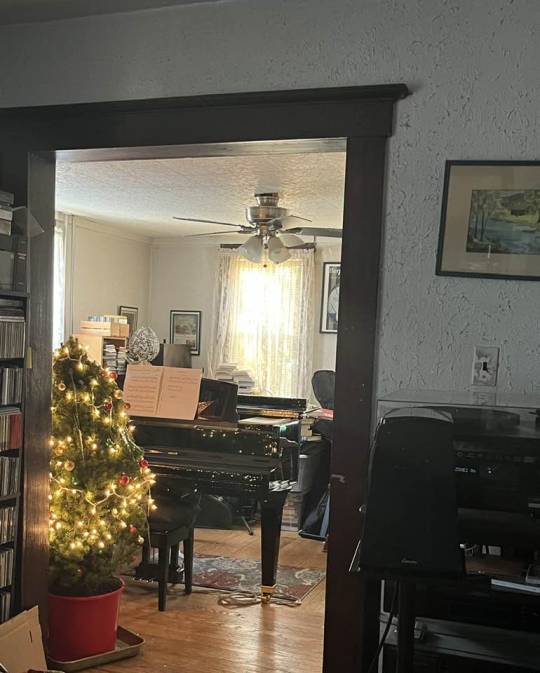
2023 was pretty much an awful year for our world —climate disaster moves ever more quickly, violence abounds and US politics are a disaster. I would not write a thank you card to the universe for many of my own experiences during the year either. However, I am grateful for the extraordinary music I participated in, heard and wrote about: it was a great solace. A few highlights are below:
I composed three new pieces: Solemn Tollings, for microtonal trumpet and trombone, Just Like You for singing violist, and Cracking Linear Elamite for solo guitar. The latter premiered in December at Loft 393 in Tribeca, played by Dan Lippel.
In addition to editing Sequenza 21 and contributing to Dusted, I authored several reviews and a research article for the British journal Tempo. The article was on my research in narratology as a feature of Elliott Carter’s music, which I have been exploring and publishing on since writing my Ph.D. dissertation. It was great for this particular research, of character-types and interactions in the Fifth String Quartet, to finally see the light of day.
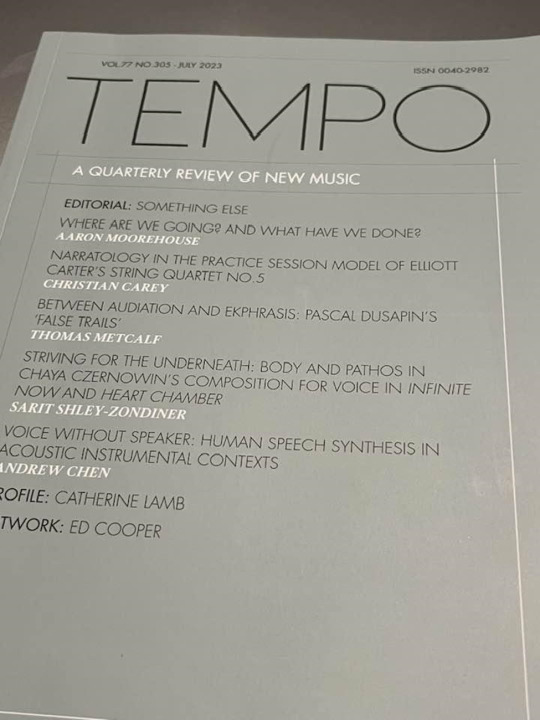
After a half-century of banged up and often unreliable used pianos, my wife Kay got me a new Baldwin grand piano for my 50th birthday. Since it has arrived, I have practically lived in it.
Post-pandemic and post-cancer, I began to dip my toe into attending live events. I went to the Tanglewood Festival of Contemporary Music, which was a mixed bag. As compensation, the Boston Symphony performances that weekend were excellent. I attended a great concert at the New York Philharmonic in November and another in December. For many years, Kay and I have made a holiday tradition of seeing the Tallis Scholars at St. Mary the Virgin Church in midtown. It was wonderful to return there. The Tallis Scholars’ performance was splendid, featuring a mass by Clemens non Papa.
After the Tallis concert, Kay was in Nashville, where her parents live, for two weeks, spending time with her brother Tom and sister-in-law Aymara, who were visiting from Qatar (Tom teaches at the Carnegie Mellon University campus there and Aymara is a yoga instructor), and celebrating Christmas with her parents. Here in New Jersey, it was just me and the felines, who were (mostly) well-behaved. To keep the holiday blues at bay, I went all out, decorating a natural tree and the house. I played every carol in the hymnal, and enjoyed old holiday standbys: Oscar Peterson, Dave Brubeck, and Mel Torme’s Christmas albums.

youtube
There was much excellent recorded music released this year, and I will not attempt to document it all. Here are twelve records, in no particular order, that I expect will stay with me and be played often in coming years.
2023 Favorite Recordings
Yo La Tengo — This Stupid World (Matador)
Hilary Hahn — Eugène Ysaÿe’s Six Sonatas for Violin Solo, op. 27 (DG)
Morton Feldman — Violin and String Quartet (Another Timbre)
Natural Information Society — Since Time is Gravity (Eremite)
Leah Bertucci — Of Shadow and Substance (Self— released)
Juliet Fraser — What of Words and What of Song (Neos)
Laura Strickling and Daniel Schlosberg — 40@40 (Bright Shiny Things)
Emily Hindricks, WDR Sinfonieorchester Köln, and Cristian Macelaru perform Liza Lim — Annunciation Triptych (Kairos)
Bozzini Quartet and Konus Quartett play Jürg Frey — Continuité, fragilité, résonance (elsewhere)
Matana Roberts — Coin Coin Chapter Five (Constellation)
Chris Forsyth — Solar Motel (self— released)
John Luther Adams — Darkness and Scattered Light (Cold Blue)
Christian Carey
#dusted magazine#yearend 2023#christian carey#elliott carter#tempo#tanglewood#tallis scholars#yo la tengo#hilary hahn#morton feldman#natural information society#leah bertucci#juliet fraser#laura strickling#daniel schlosberg#emilty hindricks#bozzini quartet#konus quartett#matana roberts#chris forsyth#john luther adams
4 notes
·
View notes
Note
1, 2, 5, 6, 9, 11, 17 for music asks!
1. A song you like with a color in the title
Blue Room-
Okay, let me think, actually.
Coconuts - Silver Lights
Daft Punk - Indo Silver Club
Pendulum - Still Grey
ODESZA - White Lies
White Lie in Black from Xanadu Next
Blue Lake from Brandish 3
Blue Moon from Brandish VT specifically
Aoki Shizuku (Azure Droplets) from Trails to Azure
Soaring Through Azure Sadness from Gurumin
Depeche Mode - Blue Dress
Spacious Blue Sky from Trails of Cold Steel
The Red Locus from Radiant Historia (this OST has at least six songs with colors in the title LOL)
Itoki Hana and Toby Fox - Skies Forever Blue
there's so much blue on here, even without Blue Room lol
2. A song you like with a number in the title
Katana ZERO-
don't worry, I'm thinking.
Sanctuary Zero from Tower of Heaven
Swedish House Mafia - One
(TIMELESS STUFF this vid is ingrained in my soul)
Blur - Tune 2 (NOT Song 2)
Exhausted 3 from Drakengard 3
4 Minutes Before Death from Ghost Trick
Dave Brubeck - Take Five
Moby - 7
Probability of Precipitation 10% from Trails from Zero
Fourteen Residents from OFF
Mikito-P - 39 Music!
Itoki Hana & Toby Fox - 74
ATOLS - $149
Daft Punk - Revolution 909
Rigёl Theatre - RiET-949
The Race of a Thousand Ants from OFF
Gorillaz - 19-2000
kemu - A Tale of Six Trillion Years and a Night (linking a human cover for you)
5. A song that needs to be played LOUD
Breath of a Serpent-
okay, the bit is getting old.
Daft Punk - Superheroes, the go-to answer
any of the battle music from Drakengard 3, literally ANY.
here's one. I am so normal don't worry about it.
Pendulum - Crush
Pendulum - Under the Waves
Pendulum - Hold Your Colour
Cibo Matto - Birthday Cake (I know this one from Jet Set Radio)
To the Edge from FF14 (by Masayoshi Soken)
6. A song that makes you want to dance
Hit the Floor.
Not even crossing out any more.
Hit the Road from Road 96 (by The Toxic Avenger)
MGMT - Electric Feel
Morandi - Afrika
Room 5 feat. Oliver Cheatam - Make Luv
Mystique - Brand New
Forest Funk from Super Meat Boy (I need to look into this game more fr)
9. A song that makes you happy
90% of what was mentioned above. Cop-out answer, but I'm already linking a ton.
When I'm sad, I usually listen to whatever I'm currently obsessed with anyway. So right now, that would be
Can't Do by Everything Everything. (thank you lol)
11. A song that you never get tired of
Stardust - Music Sounds Better With You
The Ones - Flawless
Happy Shabby Life - A Daytime Stroll in Scarecrow Field from Chulip (yes, that's the title)
Moby - Natural Blues (the 2006 version, every other one sucks ass and dick and balls and everything)
Blur - Intermission
17 was done already <3
3 notes
·
View notes
Text
𝐓𝐀𝐆 𝐍𝐈𝐍𝐄 𝐏𝐄𝐎𝐏𝐋𝐄 𝐘𝐎𝐔'𝐃 𝐋𝐈𝐊𝐄 𝐓𝐎 𝐊𝐍𝐎𝐖 𝐁𝐄𝐓𝐓𝐄𝐑!

𝐅𝐀𝐕𝐎𝐑𝐈𝐓𝐄 𝐂𝐎𝐋𝐎𝐑(𝐒): turquoise
𝐅𝐀𝐕𝐎𝐑𝐈𝐓𝐄 𝐅𝐋𝐀𝐕𝐎𝐑(𝐒): umami or sweet
𝐅𝐀𝐕𝐎𝐑𝐈𝐓𝐄 𝐌𝐔𝐒𝐈𝐂: i tend to listen to a random set of things, but lately, it's been a lot of old jazz in preparation for an upcoming ttrpg.
𝐅𝐀𝐕𝐎𝐑𝐈𝐓𝐄 𝐌𝐎𝐕𝐈𝐄(𝐒): i don't tend to watch that many movies? how to train your dragon comes to mind as a top pick. i like a lot of the fantasy and sci-fi classics too: the original star wars trilogy, the lotr movies, the matrix, the princess bride, that sort of thing.
𝐅𝐀𝐕𝐎𝐑𝐈𝐓𝐄 𝐒𝐄𝐑𝐈𝐄𝐒: I really enjoyed the Owl House recently! Gravity Falls, Danny Phantom, probably others that I've forgotten at the moment.
𝐋𝐀𝐒𝐓 𝐒𝐎𝐍𝐆: "Take Five" by the Dave Brubeck Quartet
𝐋𝐀𝐒𝐓 𝐒𝐄𝐑𝐈𝐄𝐒: The Owl House, I think?
𝐋𝐀𝐒𝐓 𝐌𝐎𝐕𝐈𝐄: Across the Spider-Verse.
𝐂𝐔𝐑𝐑𝐄𝐍𝐓𝐋𝐘 𝐑𝐄𝐀𝐃𝐈𝐍𝐆: So You Want to Be a Wizard, by Diane Duane
𝐂𝐔𝐑𝐑𝐄𝐍𝐓𝐋𝐘 𝐖𝐀𝐓𝐂𝐇𝐈𝐍𝐆: random video essays
𝐂𝐔𝐑𝐑𝐄𝐍𝐓𝐋𝐘 𝐖𝐎𝐑𝐊𝐈𝐍𝐆 𝐎𝐍: job applications,,,
Tagged by: @2ndbat
Tagging:
2 notes
·
View notes
Text
owe
cw: mentions of anti-anxiety medication
After Sadie gets the call, she doesn’t know what to do.
Maybe she was wrong for having answered it at all. But it wasn’t like she really had another choice. It’s who she is. If someone she loves calls for her, she’s going to answer, even if it is Charlie.
Charlie.
She’s spent the last two and a half years waffling between hatred for her little brother and grief that they don’t talk anymore. They used to be close. At least, that’s what Sadie likes to tell herself. When they were younger, when Sam was still alive, they used to be friends. All three of them. They used to have inside jokes about their parents, grandparents, random self-important cousins like Henry. It was always different with Charlie because he wasn’t one of the twins, but Sadie loved the hell out of him, anyway. She still remembers the first time she saw him when he was a brand new baby. She still remembers how all she wanted to do was protect him.
She wonders if maybe she protected him a little too hard.
Over the phone, Charlie asked to meet with her. Just for coffee, he said, even though he’s never been much of a coffee drinker. Maybe all those years of living in Manhattan have changed his tastes and tunes. Sadie shakes her head. She hates that she’s speculating about him when she swore she’d leave him behind. You don’t just walk away from a terrible car accident with a scratch on your finger while your brother – your brother, who died fulfilling a promise to you – winds up dead. Sadie’s stomach lurches. It’s not Charlie’s fault he didn’t die that night.
It’s his fault that he’s never stopped acting like an asshole about it.
Sadie spends hours wondering what she’s supposed to do. She said she’d return Charlie’s call within a day, one way or another. He didn’t expect her to say yes. He said he didn’t even expect her to consider it or pick up the phone, for that matter. And maybe she shouldn’t have. Sadie is finally returning to a place where she can breathe. It’s been almost a year since her last Xanax. She doesn’t go for long, late-night drives to nowhere anymore – not unless Daniel’s with her, and they’re driving toward the sunrise out of love. She used to feel like half of her was in the dirt, but she’s back now. She’s breathing, and now, she doesn’t even cough.
And now, thoughts of Charlie come up like phlegm.
Daniel says she shouldn’t feel obligated to meet with Charlie for any reason, not even the reason that they’re brother and sister. She doesn’t owe Charlie anything. All Sadie ever did for him was love and support him, and when Sam died, Charlie acted like it was nothing. Like he’d lost the only sibling who truly cared about him. Sadie couldn’t believe it when he said that at the funeral. That Sam was the only sibling who cared about him. Sam might have introduced him to Dave Brubeck, but Sadie taught Charlie how to read. She taught him how to make a plate of food in the kitchen. She taught him how to call in sick from school so you can wait in a long line for a movie everyone else will be too late to see on opening night. But as it happens, none of that mattered. She never mattered.
Sadie knows she doesn’t owe Charlie anything. That there was a time – and that time might even be now – that he loved her, but that time feels long gone. That it was never enough. Sadie might not owe Charlie anything, but she can’t shake the thought that he owes something to her.
She calls him up the next morning and tells him to meet her at the coffee house by St. Catherine’s, not for more than one hour.
Maybe then, he’ll get the picture.
Maybe then, Sadie will know that she can still breathe.
(part of @nosebleedclub july challenge -- day xvii! yes, i am doing my best all these weeks behind 😭)
2 notes
·
View notes
Text
14 Lesser-Known African American Historical Sites in Detroit | Visit Detroit
1.4 miles. That is the short distance that stood between many 19th century Black Americans and freedom in Canada.
For many runaway slaves, the shores of the Detroit River would be their last glimpse of life in the country that enslaved them.
Detroit’s history as a stop on the Underground Railroad is only one aspect of our city’s invaluable Black history.
Some of Detroit’s historical landmarks are well-known. Places like the Charles H. Wright Museum, and Second Baptist Church are not to be missed on any visit to our city. But, for those who would like an even deeper dive in Detroit’s Black history. Here’s a list of some of our faves.
Be sure to scroll to the bottom to see all of these sites mapped out for easy itinerary planning.
1.The Offices of the Detroit Plaindealer
1114 Washington Blvd., Detroit, MI 48226
An independent African American newspaper, The Detroit Plaindealer, published its first issue in May of 1863. It closed up shop somewhere around 1895.
Published by brothers Benjamin and Robert Pelham Jr. - alongside Walter H. Stowers and W.H. Anderson - The Plaindealer was the African American voice. “That was our voice,” explained Kimberly Simmons, chair of the Detroit Historical Society’s Black Sites Committee and president of the Detroit River Project, to The Huffington Post. “You had a whole group of people here, and the only way they knew what was going on was the Plaindealer. So it was a huge deal.”
The newspaper’s office was located on the southwest corner of Shelby and State Street. That space is currently occupied by the Westin Book Cadillac Hotel. A marker was recently erected to denote the historical relevance.
2. The Alger Theater
16451 E. Warren Ave., Detroit, MI 48224
While it has largely been white-owned, The Alger Theater served what evolved into the diverse historic neighborhood of Morningside located on the near-Eastside of the city.
One of only two remaining intact and unchanged neighborhood theaters, the Alger Theater was granted historic designation in 2009. The designation saved the theater from demolition.
Historically, it was a movie house that eventually showed B-movies in the late-70s and early 80s. However, earlier in its life, popular jazz acts like Dave Brubeck and the Duke Ellington Orchestra played in the 800-plus seat theater.
The Friends of the Alger Theater is a 25-year-old active non-profit organization committed to making the historic theater an anchor of this evolving neighborhood.
3. The Alpha Phi Alpha Fraternity House
293 Eliot St., Detroit, MI 48201
The home of Gamma Lambda Chapter, the 100-year-old Alpha House near downtown Detroit is home to the third oldest alumni chapter in the history of Alpha Phi Alpha Fraternity, Inc.
The building was built in 1919 and the fraternity purchased it in 1939. It is currently the meeting location, a museum, and event space for the organization.
Alpha Phi Alpha Fraternity, Inc. is the oldest Black Greek Letter Organization in history. It was founded in 1906.
4. Elmwood Cemetery
1200 Elmwood St., Detroit, MI 48207
One of the first fully-integrated cemeteries in the Midwest, Elmwood Cemetery is the resting place for a number of iconic Black Detroiters.
Former mayor, Coleman A. Young; Fannie Richards, Detroit’s first African American school teacher in the public school system; and Dudley Randall, Detroit’s former Poet Laureate, are all resting in this historic location.
Elmwood Cemetery and the Historic Elmwood Foundation launched a self-guided African American History Tour in 2015.
5. Algiers Motel Location
8301 Woodward Ave., Detroit, MI 48202
Three people were killed throughout the night of July 25-26, 1967, at the Algiers Motel in an incident during one of the darkest times in Detroit history. A period that the city has still not truly healed from.
As the 1967 rebellion raged in Detroit, several Black male youths and white women were listening to music inside the motel. One youth fired a starter pistol into the air which drew the attention of nearby officers believing they were dealing with many armed rioters.
The resulting police clash and deaths and wounding of seven others enraged the already tense community. The legacy of the Algiers Motel has been preserved in stage plays and films including the 2017 movie, Detroit.
6. The Shrine of the Black Madonna
7625 Linwood St., Detroit, MI 48206
Founded in 1967 by Albert B. Cleage, The Shrine of the Black Madonna was established as a segment of the Black Christian Nationalist Movement. The church is known for its recognition to center African Americans within the Christian narrative – a narrative that was often rooted in white supremacy.
Since its founding, the congregation at The Shrine of the Black Madonna became a powerhouse in Detroit politics instrumental in the mayoral elections of Coleman A. Young and Kwame M. Kilpatrick.
The Shrine also has a dynamic bookstore that is essential for any visitor to the historic site. The store features new and rare books on Black history and culture.
7. Masjid Wali Muhammad
11529 Linwood St., Detroit, MI 48206
Linwood Street was the site and home of much of the pan-African and Black nationalist movement. One important site is this historic masjid. This location was initially established as Temple #1 of the Black Muslim movement, The Nation of Islam.
The Nation of Islam moved into this space in 1959 and was designated a historic site in 2013.
The location was renamed in the late 70s after the death of the Honorable Elijah Muhammad. The name, Masjid Wali Muhammad was chosen in honor of the brother of Elijah Muhammad and designated a “masajid” the Arabic word for the place of worship for Muslims.
8. King Solomon Church
6100 14th St., Detroit, MI 48208
Founded in 1926, King Solomon Baptist Church has been an important center of Black life in Detroit since its founding.
The church was the site of one of the first Boy Scout troops for Black Detroiters. It was also a community center for the neighborhood. Youth outreach programs, like a boxing program led by the legendary Emmanuel Stewart, was where world champion boxer, Thomas “The Hitman” Hearns got his start.
The church was also the home of a number of gospel acts including Reverend James Cleveland and The Supremes. The church, which has 5000-seats, has also been the location of a number of historical Black speeches including two appearances by Dr. Martin Luther King, Jr.
9. Submerge Record Distribution
3000 E. Grand Blvd., Detroit, MI 48202
The world headquarters of Underground Resistance is also home to the Detroit Techno Museum.
Original records from the height of the era, including gold and platinum plaques, are on display inside the museum. It should be noted that it is only available by appointment.
The museum has been called a “mecca for true techno fans” and the music, which reflected the grime of Detroit in the 1980s. John Collins, a DJ and producer told Detroit Metro Times that techno music, which is renowned around the world, was created to give listeners “hope for the future, that things will get better.”
10. Plowshares Theatre Company
440 Burroughs St. #185., Detroit, MI 48202
Founded in 1989, the Plowshares Theatre Company has been offering a true off-Broadway experience as Michigan’s only professional African American theatre company.
The company has dedicated itself to “breaking new ground” by nurturing emerging, talented writers and actors. Named after a blade that cuts the top layer of soil in a farm, the name Plowshares refers back to the work that enslaved people did on plantations.
Producer Gary Anderson wrote that Plowshares is important because when African Americans can see themselves in artistic endeavors, like plays, it is a validation of life.
11. Dr. Ossian Sweet House
2905 Garland St., Detroit, MI 48214
This historic site does appear on a number of must-see lists for visitors to Detroit, but it remains worth mentioning again.
In September of 1925, Dr. Ossian Sweet and his wife Gladys moved into their home on Garland St., and within hours a neighborhood group gathered to run the couple out of the home. A mob of at least 400 people gathered the next night throwing stones at the house.
Someone inside the house fired shots from a second-floor window hitting a rioter who had come onto the porch and wounded another in the crowd. All of the Black people in the house were charged with murder.
Dr. Sweet was acquitted of charges after being represented by the illustrious Charles Darrow. Charges against the rest of the group were dropped. However, Mrs. Sweet contracted tuberculosis in jail and died, along with the couple’s two-year-old daughter. And years later, Sweet took his own life.
The home represents the challenges that African Americans in Detroit had in moving into primarily white neighborhoods. The city is now majority Black.
12. Whipping Post
The Southeast corner of Woodward and Jefferson Avenues
This site was the location of Detroit’s first and only whipping post. The post was used to flog thieves and vagabonds, in protection of the city’s moral codes.
The whipping post was also a location where a man could be sold for a number of days work for petty crimes although slavery was illegal in the state of Michigan.
The legacy of the whipping post is still little-known. However, it is reasonable to assume that Black Detroiters, prior to 1830 when the post was removed, were punished at the post. It is mapped on the Mapping Slavery in Detroit map created by the University of Michigan.
13. Second Baptist Church
441 Monroe St., Detroit, MI 48226
Second Baptist Church is the oldest Black-established church in the Midwest. Founded in 1836, Second Baptist Church was a station on the Underground Railroad. The church was a final stop for some 5,000 enslaved people giving them food and clothing before sending them on to Canada.

14. Elizabeth Denison Forth’s House
328 Macomb, Detroit, MI 48226
Born a slave near Detroit in 1786, Elizabeth (Lisette) Denison Forth won her freedom after she and her brother moved to Canada to establish residency, which guaranteed that they would not be returned to their previous slave owner.
Lisette became a domestic servant, but she invested all of her pay into purchasing land. She became the first Black property owner in Pontiac, Michigan. She invested in the stock market and real estate and ultimately her own home became a Michigan Historic Site.
The front doors of St. James Episcopal Church is dedicated to Lisette who was a devout Episcopalian. She dedicated her life savings of $1,500 in 1866 to the building of the church.
In 2017, she was added to the Michigan Women’s Hall of Fame for her dedication to freedom and for equality among the rich and poor.
#14 Lesser-Known African American Historical Sites in Detroit#Detroit#Black HIstory in Detroit#Black Detroit#Black People#Black Lives Matter#Black Detroit History#racism in michigan#elizabeth dennison forth
0 notes
Text
Spotify Playlist: Jazz House

Are you a fan of both jazz and house music? If so, you're in luck! We have curated a special Spotify playlist called "Jazz House" that combines the best of both genres. Get ready to groove to the smooth sounds of jazz with a modern twist of house beats.
What is Jazz House?
Jazz House is a unique blend of jazz and house music, bringing together the sophistication and improvisation of jazz with the infectious energy and electronic elements of house. This fusion genre emerged in the 1990s and has since gained popularity among music lovers who appreciate the fusion of old and new.
Why Jazz House?
Jazz House offers a refreshing and dynamic listening experience. It combines the timeless melodies and complex harmonies of jazz with the infectious rhythms and pulsating basslines of house music. This fusion creates a vibrant and uplifting atmosphere, perfect for both relaxing and dancing.
The Playlist
Our "Jazz House" playlist features a carefully curated selection of tracks that showcase the best of this genre. From classic jazz standards reimagined with a house twist to contemporary tracks that seamlessly blend jazz and electronic elements, this playlist offers a diverse range of musical styles and moods.
1. "Cantaloupe Island" - Herbie Hancock (Remixed by US3)
This track takes Herbie Hancock's iconic jazz composition and gives it a fresh and funky house makeover. The result is a catchy and groovy tune that will get your head nodding and your feet tapping.
2. "Street Life" - Randy Crawford (The Crusaders, Sampled by Nuyorican Soul)
Featuring the soulful vocals of Randy Crawford, this track combines the smoothness of jazz with the infectious energy of house. The sample from The Crusaders' original adds a nostalgic touch to this modern classic.
3. "Moanin'" - Art Blakey & The Jazz Messengers (Bobby Blanco's Block Party Mix)
Bobby Blanco's remix of "Moanin'" brings a fresh and energetic house groove to this jazz standard. The driving beats and infectious bassline give this track a modern edge while still paying homage to the original.
4. "So What" - Miles Davis (DJ Cam Remix)
This remix of Miles Davis' legendary track "So What" adds a laid-back and atmospheric house vibe to the timeless jazz composition. It's the perfect blend of old and new, creating a captivating listening experience.
5. "Take Five" - Dave Brubeck Quartet (The Cinematic Orchestra Remix)
The Cinematic Orchestra's remix of "Take Five" breathes new life into this jazz classic. With its mesmerizing electronic elements and hypnotic rhythms, this track takes you on a musical journey like no other.
How to Enjoy the Playlist
To enjoy our "Jazz House" playlist, simply open Spotify and search for the playlist title. You can also follow the playlist to receive regular updates and discover new tracks that fit the genre. Whether you're hosting a party, studying, or simply looking for some great music to relax to, our "Jazz House" playlist has got you covered.
https://open.spotify.com/playlist/5pcU1JB2yM2f5OO90PQyAO?si=ba90de6fa35a44cf
Conclusion
Jazz House is a genre that brings together the best of jazz and house music. With its infectious rhythms, soulful melodies, and vibrant energy, it offers a unique and captivating listening experience. Our "Jazz House" playlist on Spotify features a diverse selection of tracks that showcase the beauty of this fusion genre. So sit back, relax, and let the smooth sounds of jazz house transport you to a world of musical bliss.
Read the full article
0 notes
Text
dave brubeck's house is listed on zillow for a humble three sticks
1 note
·
View note
Text
In A Town Like Twin Peaks, No One Is Innocent: A Twin Peaks playlist.
Featuring: Angelo Badalamenti, David Lynch, Julee Cruise, Scott Walker, The Paris Sisters, Nine Inch Nails, This Mortal Coil, Chromatics, Jimmy Scott, The Cure, Cocteau Twins, The Platters, Julie London, Ethel Cain, Otis Redding, Mazzy Star, Rebekah del Rio, Beach House, The Cranberries, Nancy Sinatra & Lee Hazelwood, Brian Eno, Weyes Blood, Suicide, Santo & Johnny, Psychic TV, Siouxsie and The Banshees, The Zombies, The Dave Brubeck Quartet, David Sylvian, Tears For Fears, Dirty Beaches, The Veils, Yo La Tengo, Connie Stevens, Strawberry Switchblade, The Chameleons, Kate Bush, Dif Juz, Stelvio Cipriani, The Poni-Tails, Thought Gang, Chris Isaak, Skeeter Davis, Spiritualized and James Hurley.
Genres featured: Alternative rock, americana, ambient, dream pop, ethereal wave, experimental rock, folk, gothic rock, jazz, industrial, pop, post-punk, psychedelic rock and soul.
#twin peaks#music#twin peaks playlists#playlist#my playlists#david lynch#angelo badalamenti#julee cruise
3 notes
·
View notes